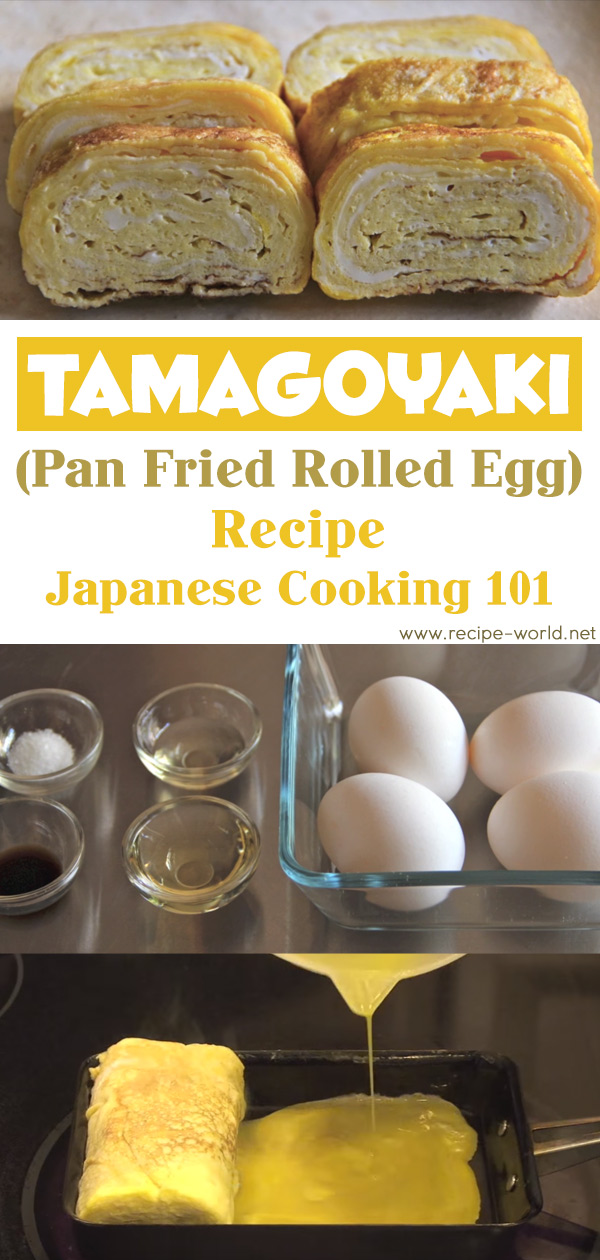Tamagoyaki is a Japanese savory-sweet rolled omelet made from eggs, salt, mirin, sugar, soy sauce, sake, and sometimes, dashi. The beaten-egg mixture is cooked and rolled in a special pan called kotoboki tamagoyaki. When the rolled omelet is sliced, a feast to the eyes is revealed: delectable thin, soft, bright-yellow sheets. This dish is usually served in Japan for breakfast. All over the world, tamagoyaki is popularly eaten as a side dish or a sushi topping.
Although most of the traditional Japanese dishes have been around since ancient times, tamagoyaki’s history is quite young. Eggs were not eaten much during the Edo Period and when egg dishes appeared in cookbooks in the mid-18th century, tamagoyaki was not included. Sugar and mirin were expensive so it was only in the 19th century that tamagoyaki recipes started to appear. In the early 20th century, the government encouraged feeding children with more protein. Eggs were considered a cheap protein source; thus tamagoyaki became a standard bento item. In sushi restaurants, some Japanese would start their meal with a tamagoyaki to assess the sushi chef’s skills, while others end their meal with it as a dessert bite.
Although tamagoyaki may seem complicated to make, this recipe will show you how quick and easy it is. The best part is that all the ingredients used are in your pantry.
Ingredients:
This recipe takes about 10 minutes to make. Serves 2 to 3.
• 4 eggs
• ¼ tsp salt
• ¼ tsp soy sauce
• 1 tbsp Mirin or sweet rice wine
• 1 tsp oil
Instructions:
Crack open the eggs into a bowl.
Add all the seasonings: salt, soy sauce, and mirin.
Beat the eggs well.
Heat a rectangular egg pan over medium-high heat
Pour about 2 to 3 tablespoons of the egg mixture into the pan.
Gently swirl the pan around so the egg covers the bottom of the pan.
Let the egg mixture cook for about 10 to 15 seconds. The top should still have some liquid but should not be runny.
Using a spatula or chopsticks, gently roll the egg into a log.
Pour another couple of tablespoons of the egg mixture into the pan.
Tilt the pan again so the egg mixture covers the bottom of the pan and the log.
Once the egg has set, roll the log back to the other end of the pan.
Repeat this process until you have used up all the egg mixture.
Remove the egg roll from the pan and let it cool for about 3 to 4 minutes.
Cut the egg roll into 1/2-inch thick slices, then transfer to a serving plate.
Ideas And Tips:
• You may substitute mirin with 1/4 tsp sugar.
• If you want a purely yellow-colored egg roll, use light soy sauce or just salt. You also have to cook the egg mixture over low heat to avoid browning.
• Each layer of the egg roll should be thin. Adding too much egg mixture into the pan makes the layer too thick, thus difficult to roll.
• Do not cook the egg mixture until it dries out. You will need the liquid on top so the egg sticks when you roll it into a log.
• You may pass the egg mixture through a sieve or strainer to remove bubbles or foam.
• If you don’t have a rectangular egg pan, you can use a regular non-stick pan.
• Sugar and mirin make the thin layers of the tamagoyaki soft and tender. Without one of them, the egg becomes tough and rubbery. If you want a sweeter tamagoyaki, you can add more sugar.

images – https://www.youtube.com/watch?v=LMCLzWIS2jc
😳 What Tinnitus Does To Your Brain Cells (And How To Stop It)
After 47 years of studies and countless brain scans done on more than 2,400 tinnitus patients, scientists at the MIT Institute found that in a shocking 96% of cases, tinnitus was actually shrinking their brain cells.
As it turns out, tinnitus and brain health are strongly linked.
Even more interesting: The reason why top army officials are not deaf after decades of hearing machine guns, bombs going off and helicopter noises…
Is because they are using something called "the wire method", a simple protocol inspired by a classified surgery on deaf people from the 1950s...


